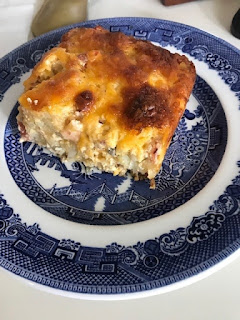My oldest daughter posed a question the other day: “Why do we talk about tuna fish salad? We don’t say salmon fish salad. Why not just tuna salad?” I have no answer, but I do know we eat a lot of it at our house, so much so that I order it by the case from a cannery. Christian and Jacob won’t eat it, Jordan only likes traditional tuna fish salad with lots of lemon and mayo. Me? I sometimes fix tuna casserole for one, or tuna Florentine (one of my all-time favorites), and I’ll even have creamed tuna on toast. But last weekend I played around with a recipe I found online, varying it enough to make it my own. It’s a sandwich billed as Italian Tuna Sandwich, primarily I suspect because it relies on salsa verde for its distinctive flavor.
The
original recipe called for a baguette, but I often find them too crunchy—the crust
gets between me and the filling. Jordan came home with what she called artisan
bread—to me it was Italian or French bread, wider and softer than a baguette. I’m
sure there’s a distinction between the two, but to me they are the same. And after
one experiment slicing it horizontally for sandwiches, I hit on slicing it
vertically, making two smallish slices. When I sliced in horizontally and asked
my dinner guest how big a sandwich she wanted, she indicated such a skinny
amount it was hard to put the filling on the bread and the whole thing ended up
being a knife-and-fork meal.
So
here’s what I did. Note that I am calling it a tuna sandwich, not tuna fish!
An Alternative tuna sandwich (serves
two)
Four slices Italian/French bread
(You’ll have lots left over to freeze for another day.)
1 7-8
oz. can good tuna (I used water-packed because that’s what I had and the salsa
verde has enough oil in it.)
2 Hard-boiled
eggs, sliced
Watercress
(if you can find it; if not some strong green with flavor, maybe even mustard
greens or romaine)
Salt
and pepper
A
basic salsa verde
4
anchovy filets (it’s sometimes hard to separate them, so use most but not all
of a tiny can, depending on how strong you want the flavor)
1 cup,
more or less, of chopped Italian parsley
1 tsp.
dried basil—if you have fresh, try ½ cup
2
cloves garlic
1
Tbsp. capers, drained
½ cup
olive oil
1
Tbsp. lemon juice
Blend all
ingredients well in food processor.
Assembling the sandwich
Use a
fork to chunk the tuna—you don’t want big chunks but neither do you want
flakes. Spread one side each of two slices of bread generously with salsa
verde. Top with chopped greens, then the tuna, and then the egg slices. Salt
and pepper the eggs, and top with second slice of bread. Enjoy!
Here’s
another recipe I found and tried. I wasn’t crazy about it, but I might try it again,
adding more spice or perhaps using lemon instead of balsamic. If you try, let
me know, please.
Italian tuna and white bean
salad
1 15-oz. can cannellini beans
1 8-oz. can corn (3/4 cup)
1 7-oz. can water-packed
albacore tuna
¼ cup chopped onion
Dress
with equal parts of olive oil and balsamic vinegar. Salt and pepper to taste. Chill
before serving.






